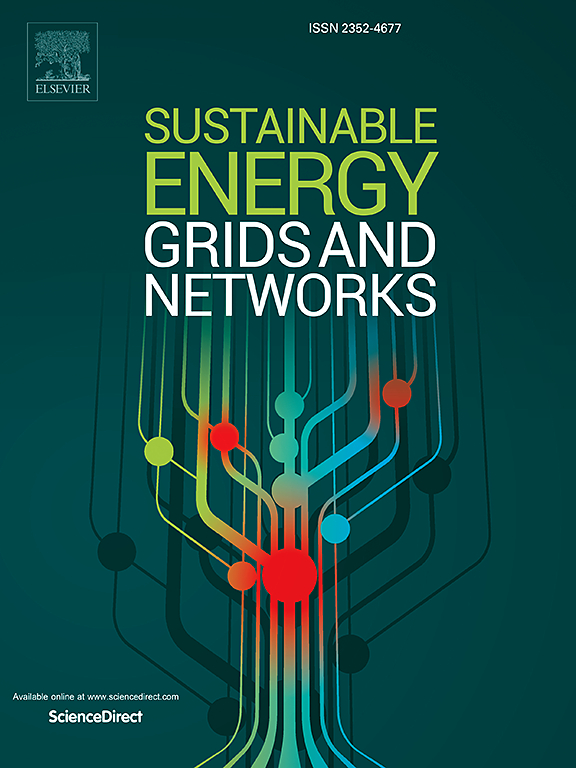办公停车场电动汽车充电策略缓解地方电网压力
IF 5.6
2区 工程技术
Q2 ENERGY & FUELS
引用次数: 0
摘要
电动汽车在城市地区的高渗透率可能导致配电系统中居民区电动汽车重充电需求集中且不协调。这种需求可能与系统的高峰需求相吻合,因此带来了与可靠性、电能质量、安全性和高压配电系统的困难运行有关的问题。如果在经济上可行,配备电动汽车充电设施的办公室停车场(opl)被视为应对这种不可抗拒的情况的切实可行的解决方案之一。本文提出了两种充电策略,即不协调电动汽车充电(UEVC)和协调电动汽车充电(CEVC),通过部署适当容量的分布式能源(DERs),如太阳能光伏(spv)和电池储能系统(BESS),最大限度地减少电动汽车充电需求对当地电网的影响。提出的CEVC策略考虑并网屋顶SPV系统的平均发电量和BESS的充电状态来调度电动汽车,并使电动汽车充电需求与SPV发电量保持一致。最后,在83总线的实际配电系统上对该模型进行了测试,研究了OPL集成对系统峰值需求、总能量损耗、峰值功率损耗和节点电压偏差等技术参数的影响。比较了两种策略的技术经济效益,并在考虑OPL车主利益的情况下计算了电动汽车停车收费。仿真结果表明,与无DERs的UEVC相比,CEVC策略使OPL年电网能源进口、OPL年峰值需求、系统总能量损失和停车费用分别降低了85%、65%、20%和11%。此外,尽管在OPL投入了大量资金,但拟议的充电策略保留了公用事业公司和OPL车主的利益,同时提供了更具竞争力的电动汽车停车费用。本文章由计算机程序翻译,如有差异,请以英文原文为准。
EV charging strategies for office parking lots to relieve local grids
High penetration of electric cars in urban areas may lead to concentrated and uncoordinated heavy EV charging demand in residential areas of the distribution systems. This demand may coincide with the peak demand of the system and consequently poses issues pertaining to reliability, power quality, security, and the difficult operation of stressed distribution systems. Office Parking Lots (OPLs) equipped with adequate EV charging facilities have been seen as one of the tangible solutions to cope with such irresistible situations if found financially viable.
This work proposes two charging strategies, uncoordinated EV charging (UEVC) and coordinated EV charging (CEVC), for OPLs to minimize the impact of EV charging demand on local grids by placing suitable capacity of distributed energy resources (DERs) such as solar photovoltaic (SPVs) and battery energy storage systems (BESS). The proposed CEVC strategy schedules EVs considering mean generation from the grid-connected rooftop SPV system and the state-of-charge of BESS and aligns EV charging demand with SPV generation. Further, the proposed model is tested on an 83-bus real distribution system to investigate the impact of OPL integration on the system’s technical parameters, such as peak demand, total energy losses, peak power loss, and node voltage deviation. Moreover, the techno-economic benefits of both strategies are compared, and EV parking charges are calculated while considering the profit for OPL owners. Simulation results show that the proposed CEVC strategy reduces the OPL’s annual grid energy import, OPL’s annual peak demand, total system energy losses, and parking charge by 85 %, 65 %, 20 %, and 11 %, respectively, when compared with UEVC without DERs. Moreover, despite heavy investment in DERs’ placement at OPL, the proposed charging strategies preserve the benefit of the utility and OPL owners, yet offer more competitive EV parking charges.
求助全文
通过发布文献求助,成功后即可免费获取论文全文。
去求助
来源期刊

Sustainable Energy Grids & Networks
Energy-Energy Engineering and Power Technology
CiteScore
7.90
自引率
13.00%
发文量
206
审稿时长
49 days
期刊介绍:
Sustainable Energy, Grids and Networks (SEGAN)is an international peer-reviewed publication for theoretical and applied research dealing with energy, information grids and power networks, including smart grids from super to micro grid scales. SEGAN welcomes papers describing fundamental advances in mathematical, statistical or computational methods with application to power and energy systems, as well as papers on applications, computation and modeling in the areas of electrical and energy systems with coupled information and communication technologies.
 求助内容:
求助内容: 应助结果提醒方式:
应助结果提醒方式:


